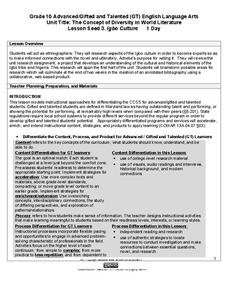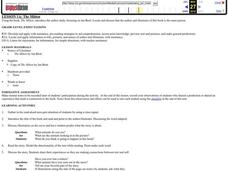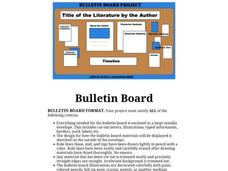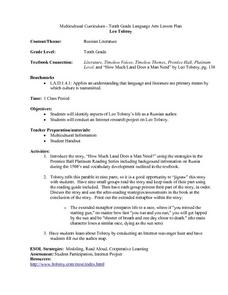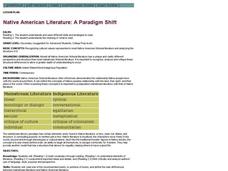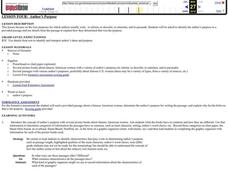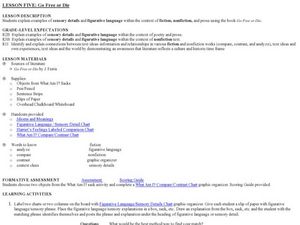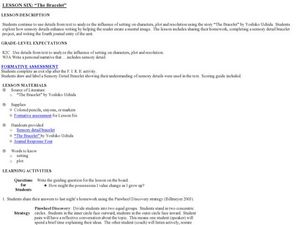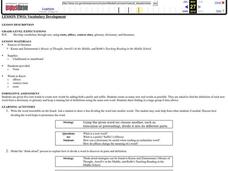Curated OER
Come Fly with Me . . . Open a Book: Travels through Literature
This detailed overview of a curriculum unit suggests using travel literature to engage and stimulate your third graders’ interest in reading. The suggested reading list includes fiction and non-fiction materials and offers urban children...
Curated OER
Responses to Literature
Middle and high schoolers hone their writing skills by reading Rikki-Tikki-Tavi and the poem Sarah Cynthia Sylvia Stout Would Not Take the Garbage Out. They fill out a graphic organizer (included here), and use the organizer to write an...
Maryland Department of Education
The Concept of Diversity in World Literature Lesson 3: Igbo Culture
What cultural concepts must readers understand in order to connect to Things Fall Apart? As part of their study of Chinua Achebe’s novel, class members research Nigeria and the Igbo culture to create a collaborative, web-based,...
Curated OER
The Mitten
Explore children's literature by researching a book and it's author. Youngsters read the story The Mitten by Jan Brett and discuss the animals and characters mentioned in the story. Then, they practice retelling their favorite portion of...
Sandra Effinger
Bulletin Board Project
Imagine a project that informs and entertains. Replace book reports with a bulletin board that highlights all the important elements of a novel. Readers research the author, create a timeline of events in the story, write a...
Curated OER
Russian Literature: Leo Tolstoy
Tenth graders research the life and literature of Leo Tolstoy. Through reading and research, 10th graders identify key events in the author's life. They explore the major themes of his writing and complete a research project. Reading...
Curated OER
Native American Literature: A Paradigm Shift
Students explore Native American literature. In this cultural diversity lesson, students read selected Native American books and analyze the themes of the books and familiarize themselves with the vocabulary used in the books.
Curated OER
Author's Purpose
Readers identify the author's purpose. First, they read a passage and utilize details from the piece to determine the author's purpose. Then they will explain how they arrived at their conclusion. Links to materials are provided.
Curated OER
Go Free or Die: Figurative Language
Figures of speech, sensory details, and academic language are all targeted while reading Chapter Two of J. Ferris’ Go Free or Die. First, learners engage in an exercise to practice describing with detail. Then, partners use a...
Curated OER
Daily Writing from Self Selected Reading
Second graders practice their reading comprehension by analyzing stories they read in class. In this children's literature lesson, 2nd graders are assigned to read a book for 20 minutes each day in class and also reflect on it in their...
National Endowment for the Humanities
In Emily Dickinson's Own Words: Letters and Poems
Analyze the depth and beauty of American Literature by reading Emily Dickinson's letters and poems. The class analyzes Dickinson's poetic style and discusses Thomas Wentworth Higginson's editorial relationship with Dickinson. They pay...
Curated OER
Wrapping It Up
Class members develop their own glossaries for unfamiliar words in each chapter in Elizabeth George Speare’s The Sign of the Beaver. After recording the word, the page number on which the word appears, and its part of speech, they...
Curated OER
Exploring Figurative Language in Fiction and Nonfiction
A reading of Pat Street's There's a Frog in My Throat launches a study of figurative language. Using a pocket chart, display one phrase containing figurative language. Class members choose the best explanation from three...
Curated OER
The Bracelet: Five Senses
Young scholars investigate the 5 senses by reading children's literature. In this descriptive writing activity, students read the story The Bracelet by Yoshiko Uchida, analyzing the story and characters as they go. Young scholars...
Curated OER
Story Elements/Characterization
Students investigate language arts by analyzing a book with their classmates. In this children's literature lesson, students read the story Scarecrow by Cynthia Rylant and discuss the setting and characters. Students create a T-Chart in...
Curated OER
Re-Read The Mitten
Students utilize their reading comprehension by analyzing a book with their class. In this children's literature lesson, students read the story The Mitten by Jan Brett and discuss the imagery and characters in the story. Students create...
Maryland Department of Education
The Concept of Diversity in World Literature Lesson 4: Proverbs
"Eneke the bird says since men have learnt to shoot without missing, he has learnt to fly without perching." As part of their study of Things Fall Apart, class members read Paul Hernadi and Francis Steen's essay, "The Tropical Landscapes...
Curated OER
Digging Deep for Figurative Language (Hyperbole)
What are hyperboles? Examine the attributes of hyperboles with your high school classes. Pupils read selected poems and prose selections that feature hyperboles and discuss their functions in each work of literature. Specific poems and...
Curated OER
A Christmas Carol Exploration
Seventh graders explore the history of Christmas by researching classic literature. In this holiday lesson, 7th graders read the story A Christmas Carol and discuss the tone of Charles Dickens' classic literary work. Students answer...
Curated OER
Writing a Reflective Paper
Students write about literature. In this writing skills instructional activity, students discuss recurring literature themes and then write reflective essays that about the themes in pieces of literature they have read.
Curated OER
Analyzing and Evaluating Literary Works
Students evaluate the literary elements found in short stories. In this literature lesson, students read short stories of their choosing and list the examples of the literary elements they encounter in the story on the provided graphic...
Curated OER
Share Stories and Discuss
Students explore literature by examining story elements. In this storytelling lesson, students identify the importance of setting, and characters within a story. Students answer questions about their personal opinions on storytelling and...
Curated OER
Irony in Poetry and Prose (Fiction and Non-fiction Texts)
Middle and high schoolers examine the impact of irony in poetry and prose. In this figurative language lesson, they read instructor-selected literature and identify uses of irony. Then they discuss how irony enhances literature.
Curated OER
Vocabulary Development
What is a root word? What is a prefix? Suffix? Use these questions to spark a discussion amongst your language art learners. Then, start by writing the word irresistible on the board and have teams of learners attempt to create new words...


